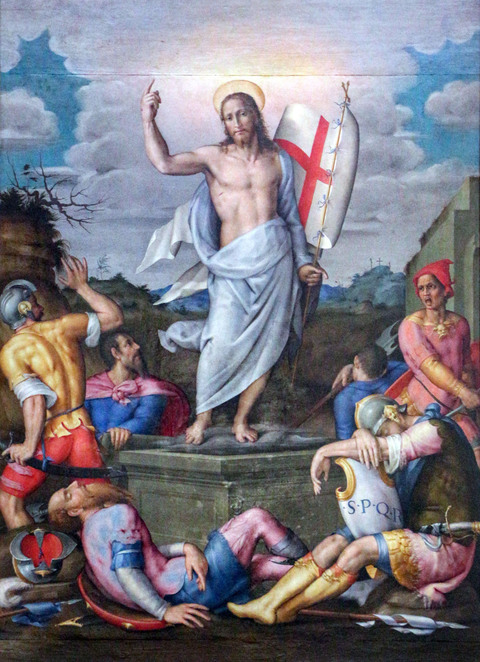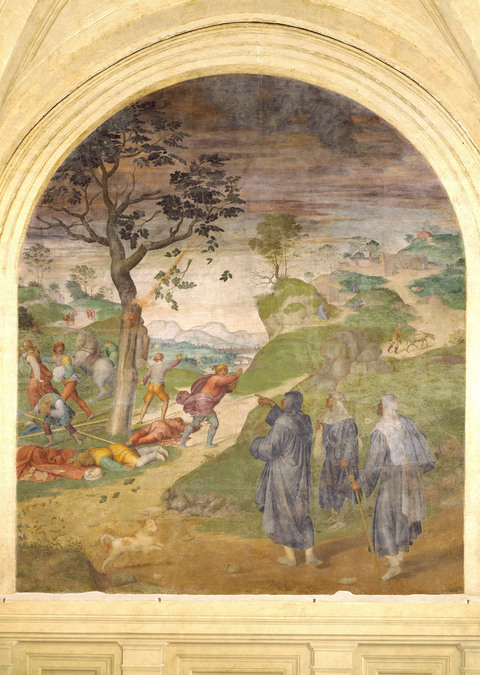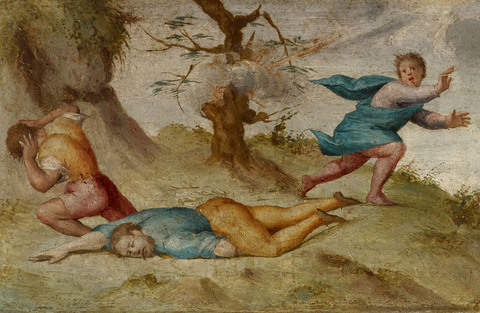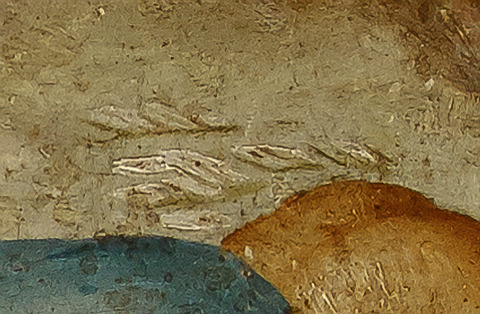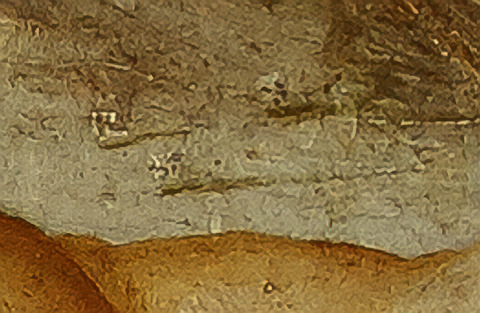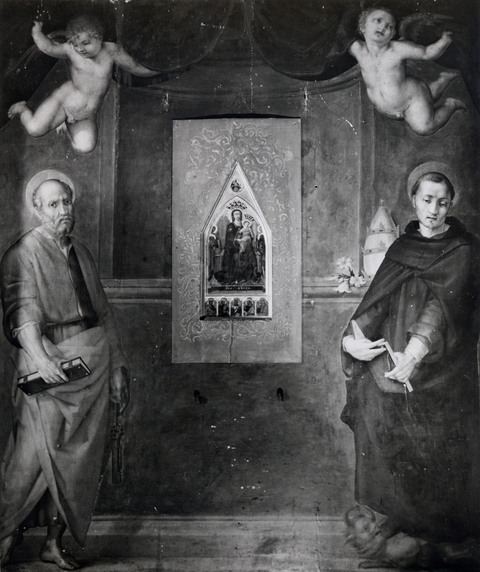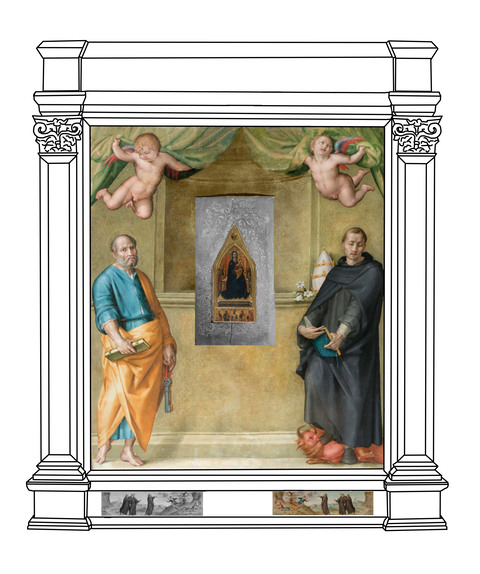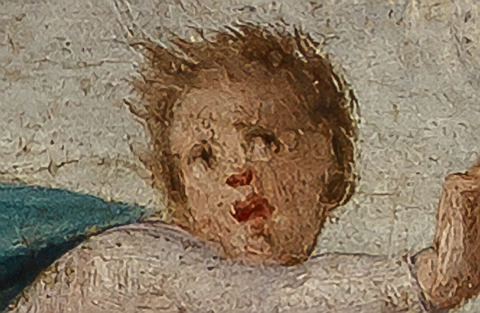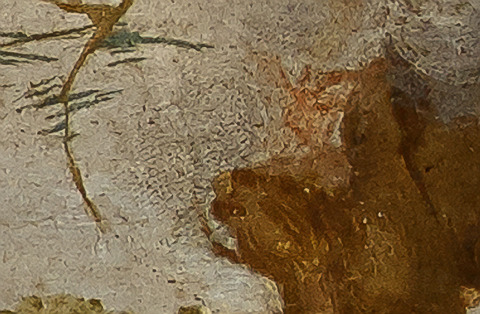Marks, Inscriptions, and Distinguishing Features
None
Entry
St. Philip Benizzi and the Gamblers entered the Clowes Collection as a work by Andrea del Sarto (1486–1530). The panel was first attributed to Pier Francesco di Jacopo Foschi (1502–1567) in 1963 by the noted historian of sixteenth century Italian art, Sydney J. Freedberg, and in 1967, art historian Antonio Pinelli gave its probable origin as a predella for a Foschi altarpiece in a church in Pisa. The attribution to Foschi still stands.
Though largely forgotten until recently, the sixteenth-century Florentine artist Pier Francesco di Jacopo Foschi seems to have had a substantial reputation in his day. He was commissioned by the Medici for at least three projects, and executed numerous altarpieces for other prominent Florentines, including three major panels in Santo Spirito in the 1540s. In addition, Foschi produced a large body of portraits, most of which are of aristocrats and high-ranking clerics. Giorgio Vasari (1511–1574) barely pays him any notice in his Vite—Foschi is only mentioned in passing in the biographies of other artists—which clearly contributed to the lapse of his reputation in subsequent centuries. His family name was not even certain until 1957; he had been referred to as Toschi until art historian Donato Sanminiatelli correctly identified him as Foschi after examining the archives of the Arte dei Medici e Speziali, the guild to which artists in Florence belonged, and the Accademia delle Arti del Disegno, the pioneering Florentine art academy of which Foschi was a notable founding member. Foschi was involved in assessing the exequies held when the body of Michelangelo (1475–1564) was brought to Florence from Rome in 1564, and he played an important role in revising the statutes of the Accademia del Disegno. In 1565, he represented the Accademia at a ceremony formalizing the agreement between the Servites of Santissima Annunziata and the artists of the Accademia regarding the use of a space within the church complex as their chapel.
According to Vasari, Foschi was a pupil of Sarto, the leading Florentine painter of the 1510s and 1520s. Sarto’s workshop trained and employed the most influential painters of the next two generations, including Franciabigio (1484–1525), Sogliano (1492–1544), Bacchiacca (1494–1557), Pontormo (1494–1557), and Rosso Fiorentino (1494–1540), and Sarto’s compositions would engender legions of copies and quotations throughout the 1500s. Foschi’s works frequently paraphrase Sarto and the cluster of artists working in his circle.
At first glance, Foschi’s large-scale paintings have a bit of an academic stiffness to them. The three panels in Santo Spirito—a
Resurrection, 1536 (fig. 1);
Dispute over the Immaculate Conception, 1544–46; and a
Transfiguration, 1546, produced in the mid- to late part of his career—exhibit a schematic rigidity and simplicity that hearkens back to Sarto’s example. However, the reduced focus on the doctrinal theme indicate that these works may be among the earliest responses to the Counter-Reformation call to make the sacred substance of the image as manifest as possible. In so doing, Foschi was taking steps to break from the elaborate
maniera stylizations that dominated the artistic language of his day. His figures still reflect the self-conscious postures seen in works of his contemporaries, but, unusually for his time, those of Foschi largely omit the distracting gesticulations and ornament of the Mannerist style. There are, additionally, beautiful touches to his work. The Santo Spirito
Resurrection, for example, employs a carefully calibrated color scheme, setting the candy red, rose, blue, yellow, and lavender colors of the soldiers around Christ against the backdrop of a dusky blue sky.
Figure 1: Pier Francesco Foschi (Italian, 1502–1567), Resurrection, 1536, oil on wood, 106-19/64 × 81-57/64 in. Church of Santo Spirito, Florence.
Figure 1: Pier Francesco Foschi (Italian, 1502–1567), Resurrection, 1536, oil on wood, 106-19/64 × 81-57/64 in. Church of Santo Spirito, Florence.
Freedberg, who still used the surname “Toschi” in his attribution of the Clowes panel, provided no commentary on his judgment. But strong stylistic links can be seen between the Clowes panel and other Foschi works. An unmistakable curve-and-tuck pattern to the outlines of the figures matches the contours of figures found in the artist’s accepted works, and the color palette in the Clowes panel is very similar to that of Foschi’s altarpieces in Santo Spirito.
The composition closely follows an early work of Foschi’s master: Sarto’s fresco of the
Punishment of the Disbelievers, 1510, for the
Life of St. Philip Benizzi cycle in the Chiostrino dei Voti of Santissima Annunziata in Florence (fig. 2). Santissima Annunziata is the mother church of the Servites, a prominent mendicant order centered in Florence. The Servites, or Servants of the Order of Mary, were founded in 1233 by seven Florentine cloth merchants who left the city to lead a life of penance and poverty. Devoted to meditations on the suffering of Mary, they settled in a wilderness retreat at Monte Senario, some miles outside the city. The Servites are still very active within the Catholic Church, and Santissima Annunziata remains a hub of intense cult devotion, the focus being a fourteenth-century
Annunciation, one of the most revered miracle-working images in Italy.
Figure 2: Andrea del Sarto (1486–1530), Punishment of the Disbelievers from the Life of St. Philip Benizzi cycle, 1510, fresco. Santissima Annunziata, Florence, Italy. Photo Credit: Scala / Art Resource, NY.
Figure 2: Andrea del Sarto (1486–1530), Punishment of the Disbelievers from the Life of St. Philip Benizzi cycle, 1510, fresco. Santissima Annunziata, Florence, Italy. Photo Credit: Scala / Art Resource, NY.
St. Philip Benizzi (1233–1285), one of the most important saints venerated by the Servites, rescued the order from suppression in the late 1200s, and he was responsible for the propagation of the order across Europe into the 1300s. He was beatified by the Medici Pope Leo X (1475–1521) in 1516—not long before this panel was painted—but not canonized until 1671. As Philip is the subject of this work, the Clowes painting was likely made for a Servite context, and the rectangular format suggests its original function as a predella for an altarpiece.
This panel depicts an episode in the summer of 1263, when Philip and a few Servite brothers paused on a journey from Modena to Bologna to rest in the shade of a great elm. Nearby, under the same tree, was a band of gambling soldiers and women. Hearing the devotional prayers of the brothers, the gang began to mock them and profane the name of God. Philip Benizzi admonished the lascivious band, quoting St. Peter: “If anyone speaks, they should do so as one who speaks the very words of God” (Si quis loquitur quasi sermones Dei, 1 Pet. 4:11). His words only increased their outrage, but Philip warned that if they did not stop and repent, they would face God’s imminent wrath. The encounter escalated, and the group threatened to thrash the brothers. Philip repeated his prophecy and, as he and the brethren turned to leave, the clear sky suddenly became dark and stormy. A lightning bolt struck the tree, reducing it and the mob to ashes. Philip and his followers saw the destruction from a distance, whereupon they knelt down and prayed for an hour.
Sarto’s fresco is possibly the first, and certainly the most celebrated, image to portray this episode from Benizzi’s life. Philip’s gesture as he points to the gamblers reads almost as a declaration of speech, as if this is the moment of the saint’s prophecy. Sarto thus conflates the episode with that of the group’s departure and witnessing of the gamblers' destruction from afar. This narrative invention is a kind of visual metonymy, by which one gesture can simultaneously suggest two episodes. The sky becomes increasingly dark at the top of the fresco, and a lightning bolt hits the tree and strikes down a few of the gamblers, while others flee in terror. The dead soldier beneath the tree trunk has fallen headlong toward a pile of cards scattered in the chaos. Sarto also has Servite sisters accompanying Philip, a detail not found in the literary versions of the story.
In the limited space of the panel, Foschi paraphrased Sarto’s large-scale fresco in miniature, reducing the narrative to its key elements. Sarto’s landscape path, coursing between two mountains, has been stretched to fit the horizontal format of Foschi’s panel. Foschi replaces the Servite sisters who accompany Philip with two brothers, and the number of gamblers has been reduced from seven to three, but the poses of those three figures are derived wholesale from Sarto’s composition. And Foschi again has Philip gesturing to the gamblers, which the two brothers on the right reinforce by pointing in the same direction. As in Sarto’s fresco, a lightning bolt extends straight from the upper heavens to shatter the tree, but more is made of the smoke and flames that engulf the central column of the trunk. This is one of the most poetically imaginative passages in Foschi’s oeuvre. The radiance of the flames, revealed and obscured in the smoke, is magnificently suggested (fig. 3).
Figure 3: Pier Francesco Foschi (Italian, 1502–1567), St. Philip Benizzi and the Gamblers (detail), about 1540, oil on panel, 5-1/2 × 23 in. (panel). Indianapolis Museum of Art at Newfields, The Clowes Collection, 2016.165.
Figure 3: Pier Francesco Foschi (Italian, 1502–1567), St. Philip Benizzi and the Gamblers (detail), about 1540, oil on panel, 5-1/2 × 23 in. (panel). Indianapolis Museum of Art at Newfields, The Clowes Collection, 2016.165.
Foschi’s close attention to the narrative and Sarto’s precedent is seen in his inclusion of the playing cards and dice. Foschi places the cards just above the gambler’s torso at the base of the tree, while a set of three dice sit to the right, above that figure’s thigh (figs. 4–5). The sides of at least one of the dice is touched with the slightest dots of black to identify their value. This detail, which was only noticed in a recent technical analysis of the panel, is easy to overlook and was executed with such delicacy and restraint that one wonders if the artist painted this for his own delight.
Figures 4–5: Details of cards and dice. Pier Francesco Foschi (Italian, 1502–1567), St. Philip Benizzi and the Gamblers, about 1540, oil on panel, 5-1/2 × 23 in. (panel). Indianapolis Museum of Art at Newfields, The Clowes Collection, 2016.165.
The Foschi predella links figures through color combinations. The fleeing figure at left is clad in ocher and a distinct rose-madder shade. The fallen figure is in the same ocher, as well as an almost Prussian blue. The fleeing figure at right is in the same blue hue, paired with the rose color seen in the figure at left. This cycling of colors through figures is also seen in the Santo Spirito Resurrection of 1537, where a rose color similar to that in the Clowes panel is paired with blue, and the same ocher is paired with red. All six figures around Christ in the Santo Spirito Resurrection feature the four colors of the Clowes panel.
In 1967, Pinelli first proposed the idea that the Clowes panel had originally served as a predella for an altarpiece of
Saints Peter and Filippo Benizzi, still
in situ as the high altar of the church of San Benedetto a Settimo, in San Benedetto in the
comune of Cascina, near Pisa (fig. 6).
This church had been taken over from the Benedictine order and remodeled by the Servites in 1535–40. Foschi’s altarpiece featuring St. Philip was probably a part of the reorganization of the church under Servite rule, which would place the panel to sometime around the years of the remodeling.
Figure 6: Pier Francesco Foschi (Italian, 1502–1567), Saints Peter and Filippo Benizzi flanking the Madonna del Piano, about 1535, oil on panel, 87-51/64 × 72-53/64 in. Church of San Benedetto, San Frediano a Settimo Cascina, Tuscany. Photo Courtesy Fondazione Federico Zeri, Università di Bologna, Zeri Photo Library, 34278.
Figure 6: Pier Francesco Foschi (Italian, 1502–1567), Saints Peter and Filippo Benizzi flanking the Madonna del Piano, about 1535, oil on panel, 87-51/64 × 72-53/64 in. Church of San Benedetto, San Frediano a Settimo Cascina, Tuscany. Photo Courtesy Fondazione Federico Zeri, Università di Bologna, Zeri Photo Library, 34278.
The altarpiece, attributed to Pontormo until Pinelli advanced the most accepted attribution to Foschi, presents the artist’s signature curve-and-tuck pattern in the figures' outlines, and a large, almost featureless backdrop, conferring a monumental sobriety to the standing figures, seen in Foschi’s other larger works. Many passages display that insistent method distinct to Foschi of suggesting volume by placing a counter-highlight within the shadow near the edge of a form. The panel frames the so-called Madonna del Piano, a venerated work of the late trecento Florentine School for which the church is sometimes named. The original framing is unknown, but it seems that a more elaborate surround was added in the eighteenth century. The entire altarpiece has been encased in a deep marble niche, and electrical fixtures were installed to light it. Pinelli identifies a drawing in Christ Church, Oxford, as a preparatory sketch for the altarpiece, and another in the Windsor Royal Library collection as a study for the head of St. Peter. The preparatory sketch indicates a niche was to have enclosed the trecento panel, but as executed there is only a fictive niche that begins midway up Foschi’s altarpiece. The practice of taking an older devotional panel and reframing it in a contemporary-style altarpiece became popular in the 1500s and, in this instance, may have a political dimension. The emphatic placement of St. Philip Benizzi in the right of the altar may be part of an effort on the Servites' part to legitimize their takeover of the previously Benedictine space by appropriating a locally revered panel and placing it in juxtaposition with a saint (although he was at this point still a beato) representing the new Servite control of the Pisan church. A Florentine-based religious order thus asserts its domain in Pisan territory, subordinating local religious observance to a larger, central authority. It is important to note here that Pisa and its environs provided a highly coveted link to the sea, and Florence had avidly sought to maintain possession of this link since it subdued the territory in 1509. The San Benedetto a Settimo altarpiece may then be a part of that phenomenon of cultural and religious initiatives used to integrate subject territories within the political orbit of Florence, as observed by Richard Trexler.
If, as seems most likely, the Clowes panel served as the predella for the San Benedetto a Settimo altarpiece, the color notes of the left figures would have picked up the yellow and blue robes of Peter on the left side of the altar. Meanwhile, St. Philip Benizzi and his two Servite brothers in the middle of the predella are clad in the same sober Servite colors as the monumental figure of Philip, which would have loomed over the panel in its original placement on the bottom right of the altarpiece. While it would be logical for Foschi to paraphrase his master in portraying what was to this point a rarely depicted narrative, the evocation of the scene in the cycle of St. Philip in Santissima Annunziata may also have been a way to visually connect the Pisan church of San Benedetto to the Servite order and its mother church in Florence. The presence of a predella panel dedicated to St. Philip Benizzi on the bottom right suggests that St. Peter had a similar panel as its complement on the left (fig. 7).
Figure 7: Reconstruction of Foschi’s Saints Peter and Filippo Benizzi, Church of San Benedetto, Tuscany, with predella panel of Foschi’s St. Philip Benizzi and the Gamblers, Indianapolis Museum of Art at Newfields, The Clowes Collection, 2016.165.
Figure 7: Reconstruction of Foschi’s Saints Peter and Filippo Benizzi, Church of San Benedetto, Tuscany, with predella panel of Foschi’s St. Philip Benizzi and the Gamblers, Indianapolis Museum of Art at Newfields, The Clowes Collection, 2016.165.
Like other artists of his time who followed the example of Raphael and some of the
maniera artists of the earlier cinquecento, Foschi allows himself more painterly liberties in the predella. The hard contours of the monumental figures, arranged symmetrically in the main panel, contrast with a liquidity of touch and a more informal composition of figures that relieves the severity of the large altarpiece above. Upon close observation, certain passages, such as the handling of the upturned face of the fleeing youth (fig. 8), are similar to the impressionistic touch of antique Roman wall painting, suggesting Foschi’s familiarity with such artists as Domenico Beccafumi (1486–1551), if not antique Roman painting directly. Something of the Mannerist delight in
sprezzatura can be seen in this panel in the virtuosic display of invention and the free handling of paint. A variety of marks are found, from the fluid movement of the lines defining the cards and the blobs of paint that suggest tree leaves, to the grasses rendered with the slightest flick of the brush. A technical analysis of the panel revealed that Foschi’s suggestion of the pulverization of the tree was partly achieved by dabbing the paint with his fingers, leaving a print (fig. 9).
Figure 8: Detail of face of fleeing figure. Pier Francesco Foschi (Italian, 1502–1567), St. Philip Benizzi and the Gamblers, about 1540, oil on panel, 5-1/2 × 23 in. (panel). Indianapolis Museum of Art at Newfields, The Clowes Collection, 2016.165.
Figure 8: Detail of face of fleeing figure. Pier Francesco Foschi (Italian, 1502–1567), St. Philip Benizzi and the Gamblers, about 1540, oil on panel, 5-1/2 × 23 in. (panel). Indianapolis Museum of Art at Newfields, The Clowes Collection, 2016.165.
Figure 9: Detail of fingerprint in tree. Pier Francesco Foschi (Italian, 1502–1567), St. Philip Benizzi and the Gamblers, about 1540, oil on panel, 5-1/2 × 23 in. (panel). Indianapolis Museum of Art at Newfields, The Clowes Collection, 2016.165.
Figure 9: Detail of fingerprint in tree. Pier Francesco Foschi (Italian, 1502–1567), St. Philip Benizzi and the Gamblers, about 1540, oil on panel, 5-1/2 × 23 in. (panel). Indianapolis Museum of Art at Newfields, The Clowes Collection, 2016.165.
More work remains to carefully examine the original altarpiece, now ensconced within a close-fitting marble niche, and to search archival notices of the altarpiece, the altar’s patrons, why these two saints were chosen to frame an older venerated image, and when the altarpiece was cut down and reinstalled. Connections between Foschi and the Servite community of Santissima Annunziata need to be further explored, considering the multiple occasions Foschi interacted with them. It seems very telling that Foschi was chosen to produce this important altarpiece for the Servite remodeling of San Benedetto a Settimo and that he served as representative of the Accademia del Disegno in the ceremony formalizing the agreement between the Servites and the Florentine Academy in 1565.
Author
Gustav Medicus
Provenance
Probably served as a predella to the altarpiece, Saints Peter and Philip Benizzi flanking the Madonna del Piano, on the high altar of the parish church of San Benedetto a Settimo in Cascina (Pisa).
Giuseppe Toscanelli (1828–1891), Pisa and Florence, until 1883.
Probably Armand Georges Lowengard (died 1943), Paris.
(Boehler and Steinmeyer, Lucerne), around 1922.
Julius H. Haass (1856–1931), Detroit;
To his wife Mrs. Lillian Henkel Haass (1879–1960], Detroit;
(Newhouse Galleries, New York);
G.H. A. Clowes, Indianapolis, in 1958;
The Clowes Fund, Indianapolis, 1958–2016, and on long-term loan to the Indianapolis Museum of Art since 1971 (C10072);
Given to the Indianapolis Museum of Art, now the Indianapolis Museum of Art at Newfields, in 2016.
Exhibitions
John Herron Art Museum, Indianapolis, IN, 1959, Paintings from the Collection of George Henry Alexander Clowes: A Memorial Exhibition, no. 52;
A Lenten Exhibition, 1962, University of Notre Dame Art Gallery, Notre Dame, IN, no. 45;
Italian and Spanish Paintings from the Clowes Collection, 1962, Indiana University Museum of Art, Bloomington, IN, no. 11.
References
G. Sambon, Catalogue de la Collection Toscanelli de Florence (Florence : [Sambon], 1883), p. 22, no. 85, plate XIX (as Andrea del Sarto);
S. Reinach, Répertoire des peintures du moyen age et de la renaissance, 6 vols. (Paris: Ernest Leroux, 1905–23), 1:539 (as Andrea del Sarto);
Paintings from the Collection of George Henry Alexander Clowes: A Memorial Exhibition, exh. cat. (Indianapolis, IN: John Herron Art Museum, 1959), no. 52 (reproduced);
Sydney J. Freedberg, Andrea del Sarto, 2 vols. (Cambridge, MA: Harvard University Press, 1963), 1:221 (as in Haass collection, and attributed to Toschi);
John Shearman, Andrea del Sarto, 2 vols. (Oxford: Clarendon Press, 1965), 2:200, cat. no. 8 (not by del Sarto);
Antonio Pinelli, “Pier Francesco di Jacopo Foschi,” Gazette des beaux-arts, ser. 6, vol. 69 (1967): 94, fig. 9, 105–6;
Mark Roskill, “Clowes Collection Catalogue” (unpublished typed manuscript, IMA Clowes Archive, Indianapolis Museum of Art, Indianapolis, IN, 1968) (Foschi);
Roberto Nuccetelli, s.v. “Foschi, Pier Francesco,” Dizionario biografico degli Italiani 49 (1997) http://www.treccani.it/enciclopedia/pier-francesco-foschi_(Dizionario-Biografico)/
Notes
